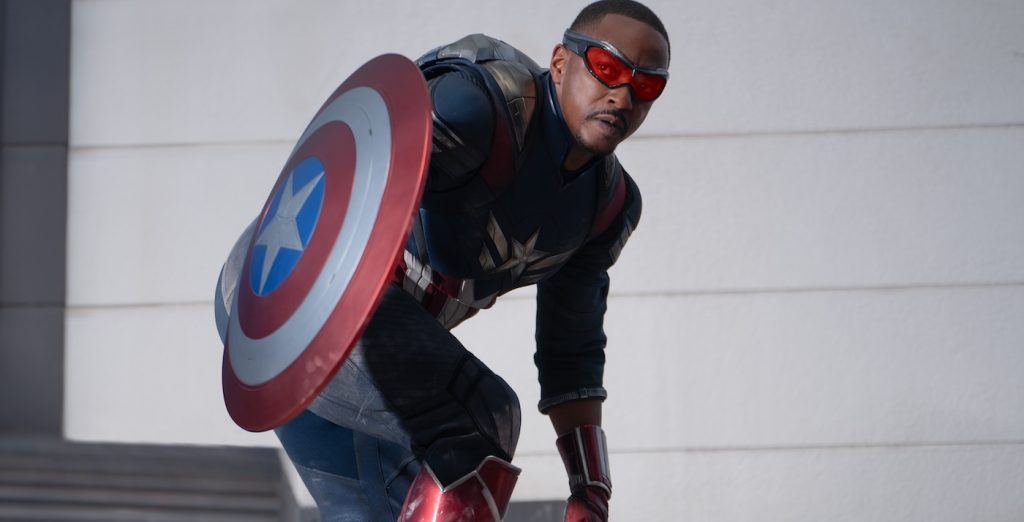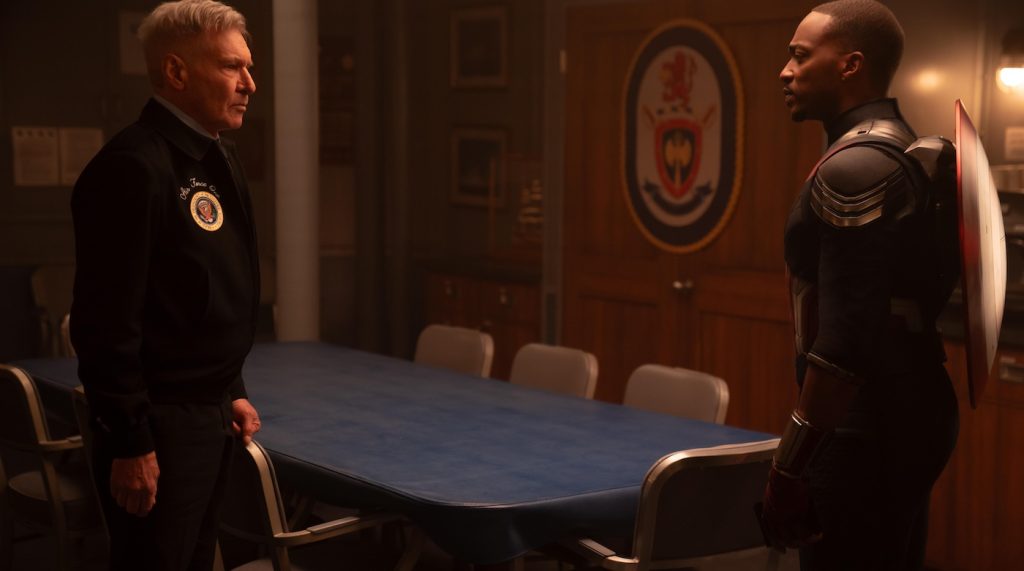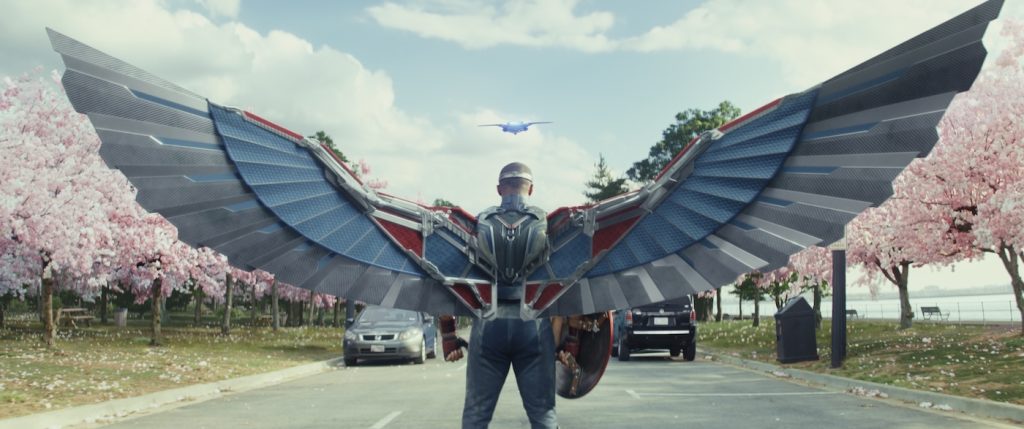Red Alerts & Cherry Blossom Brawls With “Captain America: Brave New World” Production Designer Ramsey Avery
When Steve Rodgers (Chris Evans) passed the Captain America shield to Sam Wilson (Anthony Mackie), the former Falcon sidekick had big boots to fill. The same could be said for production designer Ramsey Avery in developing director Julius Onah’s Captain America: Brave New World, which has earned over $200 million worldwide at the time of publishing.
Avery, who touts decades of credits, including being on the art department teams of Guardians of the Galaxy Vol. 2 and Spider-Man: Homecoming, is no stranger to designing superhero settings. But what makes Brave New World visually appealing is how the environments look and feel real. Not to say VFX supervisors Bill Westenhofer (Life of Pi) and Alessandro Ongaro (The Adam Project) didn’t have heavy lifting to do. They very much did. But Onah’s film delivers themes of self-identity and reflection on a visually photorealistic platter over a feast of blue screen magic.
“One of the directives in this movie was that it had to be grounded. That was a big word. Our discussion of it was getting to a grounded characteristic, a gritty characteristic, a visceral characteristic where the audience felt it was super real. And so we tried as much as we could to do everything in camera,” says Avery.
For the story that sees Sam on a chase all over the world, including Mexico, West Virginia, and a climactic clash with U.S. President Thaddeus Ross (Harrison Ford) in Washington D.C., production was based in Atlanta, Georgia, at Trilith Studios, with additional time at Tyler Perry Studios and on location in D.C. to film its iconic landmarks. Among the dozens of sets Avery designed, he was tasked with replicating the White House, its Rose Garden, and D.C.’s Hains Point.
Below, he discusses those challenges, how color influenced design choice, and the best way to destroy a city.
Iconography
With Sam Wilson as the new Captain America, it was important to keep the iconic images of the character in familiar territory.

Avery: In terms of the iconography specific to Captain America, all of that comes from Ryan Meinerding [head of visual development at Marvel Studios]. He and his department are responsible for developing that specific superhero imagery in interaction with the Marvel executives and the director. Then, in many cases, that has to go down to the costume designer to figure out how to make it real. So, it’s hard for us in production design to take much specifically from that or the comic books because the MCU isn’t the comic books. There’s a different history going on and we’re not encouraged to dig too deep into all of that. What we were really interested in is what’s going on in Sam’s head, what’s his journey through this movie, and how do we show that in a visual narrative to the audience.
Self-Identity
The story’s emotional through-line has Sam finding his way as Cap, while President Ross is trying to escape a troubled past. Self-identity is a theme of the narrative, and the production designer infused visual motifs to support it.
Avery: Both Sam and Ross are having a bit of an identity crisis and trying to figure out who they are, what they want to be, how they want to be perceived, and what they want to project. Talking with Julius and also the costume designer, cinematographer, and visual effects about how we’re going to convey all of that, we ended up in two general strokes. And one was to look at the volumes of the volumetric space of the storytelling.
At the beginning of the story, both characters are stuck in boxes of their own making. We looked for ways to craft environments that start off keeping them enclosed, such as smaller shapes or darker areas—things that make them feel more isolated in their worlds.

We see Ross at the very beginning of the movie making a big speech in New Hampshire in this huge space. But we find him first stuck backstage, back behind some glass, where we get that sense of that reflection playing towards him figuring out who he is and what he’s going to do. And even when he walks out on stage, he’s separated from the audience by those glass panels so that he’s still contained within his world. Similarly with Sam, in that fight sequence at the very beginning, one of the things that you can see is that it ends up getting enclosed in these darker, tighter spaces. So there’s a whole arc of that type of volume exploration where they detail their identities until the very end.
Story through Color
Production design shifted the color palette to inform emotion, with shades of blue hinting at control while warmer hues allude to disorder.
Avery: We did a whole color script for the movie and discussed the color, lighting, and composition of the scenes. We know that the Hulk is red, and the journey for Ross is from control to chaos, so we wanted to explore this idea of control to lack of control. We developed a color palette for the movie where blue represents things mostly in control or where people think they’re in control. Then we go through green to yellow to orange to red, where you lose control as you get to red. You’ll see in Sam’s office there’s more blue. There’s also blue in the room where Sam and Ross meet for the first time when they go into the East Room. That type of playing with color carried through the whole storyline.
A Rose Garden Showdown
During a speech in the White House Rose Garden, Ross loses his control over the Hulk, unleashing the red beast. Can Cap save the day?
Avery: We did a lot of research to figure out the Rose Garden. We looked historically at what different Rose Gardens were to say something about our Rose Garden and our Ross. We looked back to the Kennedy when there was this kind of aspirational sense of what the White House was trying to sell itself on. So we use some of that Rose Garden because that’s the same thing that Ross wanted – this idea about being aspirational and looking forward and keeping some optimism.
Then, we decided to build the Rose Garden true to size. We also studied Julius’s movie references, which were these 1970s political thrillers, and how those movies framed their shots. We looked at how we would use those really strong lines in the Rose Garden to give us a sense of strong framing and a sense of control. Then, when all hell breaks loose, we break all of the clean lines and those strong geometries.
We wanted to do as much destruction as we could practically, too. So when Hulk pulls out that column, a lot of that is a practical effect. The lectern that gets tossed is real, and the stage collapsing. All of those things are practical elements that then get enhanced. It brings that reality and makes it more grounded.
A fight among the Cherry Blossoms
A climatic sequence had the production designer re-creating Hains Point, which required a towering three-sided blue screen and help from the greens department.
Avery: The wish was to shoot in D.C., but for all kinds of reasons, it didn’t make sense. So it fell on the art department and talking with the director, DP (Kramer Morgenthau), and visual effects to sort it out. We went to Hains Point in D.C. and researched it. But the actual fight happens within about a two-thirds size of a football field set we built in the same place as the Rose Garden. There was a whole process of figuring out how to use the same footprint to make it look bigger than it really was. So, we rearranged light poles, cars, fences, and trees to figure out things logistically.
We actually filmed the destroyed version of Hains Point first, then the clean version. We first built the clean version and then built the destroyed version on top of the clean version. Then over a couple days we removed all the destructive stuff out, exposing the clean stuff underneath and put in new cherry blossom trees.

Captain America: Brave New World is in theaters now.
Featured image: Red Hulk/President Thaddeus Ross (Harrison Ford) in Marvel Studios’ CAPTAIN AMERICA: BRAVE NEW WORLD. Photo courtesy of Marvel Studios. © 2024 MARVEL.



